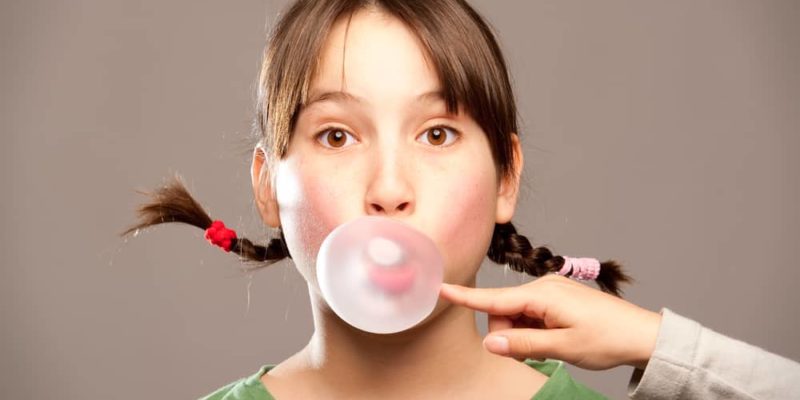When you talk to world-famous evolutionary biologist Paul Ehrlich and Orthodontist Sandra Kahn who wrote Jaws: The Story of a Hidden Epidemic, you discover quickly how our lifestyle has impacted our jaw development. And if you don’t think your jaw size is important, hear this–the size of your jaw impacts your health in ways you would have never thought including how you sleep, how much you weigh, and how prone you are to cardiac arrest. Changes in the modern lifestyle have impacted our jaw development to such an extent that experts are recommending gum chewing and several other techniques that help encourage the jaw to develop stronger and bigger. Gum chewing may not be a polite thing to do in public, but it helps jaw development early in life. You’ve trusted Mamavation to bring you topics like what problematic ingredients show up in school lunches, plastic-free food storage container ideas, & how to take an allergic child out to a restaurant, now join us as we explore jaw formation in children, how that can lead to disease later in life, and what you can do RIGHT NOW to help your family avoid these things.
Disclosure: This post contains affiliate links.
Table of Contents
Human Jaws Have Changed Dramatically and It’s Impacting Public Health
Did you know that hunter-gatherers didn’t have the concept of wisdom teeth? There was plenty of room for all the teeth they had in their mouth. Wisdom teeth were just teeth. According to evolutionary biologist, Paul Ehrlich, it was highly unlikely hunter-gatherers would have even had crooked teeth like you see today. There was plenty of room for all the teeth in their mouth. So there was never any need to pull wisdom teeth to make room for other teeth. The problem of wisdom teeth and braces is one for the modern world.
“We’ve subjected humanity, species that are hundreds of thousands of years old, in about 8,000 years, to a huge environmental change. And relatively few generations we have gone from hunter-gathers…to settling down to agriculture to moving more and more to liquid diets. And that has made these huge changes.” said Paul R. Ehrlich.
Today, there is an epidemic of “malocclusion” which is a condition where the mouth has a small jaw and crowded, ill-aligned teeth. This condition is often accompanied by mouth breathing, can change the appearance of the face & quality of life, and makes one more susceptible to disease. While modern times have focused on orthodontics and fixing the spaces with braces, this is a much bigger issue. Jaw size can impact breathing during the night. People with malocclusion are more likely to have sleep apnea and struggle with sleep for the rest of their lives. Sleep deprivation is linked with higher rates of cardiac arrest among other things. So an increase in malocclusion would be problematic for public health.
“Survey data reveals that about a fifth of the population has significant malocclusion, and the irregularity in the incisors (crowding of the front teeth) is severe enough in 15% that both social acceptability and function could be affected. Well over half have at least some degree of orthodontic treatment needed.”
How We Eat & What We Eat Has Impacted Our Jaw Development
Jaw development in modern times has changed dramatically and there isn’t really any argument about that. But what is new is the realization of HOW this has happened over modern times. Some have argued that over time, our jaws have changed over evolution, but there is no evidence to support that. The jaw potential has stayed the same since hunter-gatherer times. What has changed is whether the jaw develops and grows to fit the rest of your teeth and tongue. When babies and young children are given the opportunity to exercise their jaws, they develop larger jaws capable of handling all their teeth. But when their jaws are not exercised, they do not develop to their full potential. And that leads to health problems later in life. Here are some of the modern-day activities that are linked to poor jaw development.
- Bottle feeding babies
- Weening babies too early
- Introducing soft baby foods that have been pureed
- For adults: eating soft foods like smoothies, ground beef, ice cream, or anything else where the original ingredient needed to be chewed to be eaten
- Mouthbreathing
- Poor posture
Health Impacts Tied to Jaw Malocclusion
Because malocclusion is linked so closely to sleep apnea, the size of your jaw can impact more than just whether you get braces or not. The side effects of sleep apnea can be rather serious. Sleep apnea is a serious sleep disorder where a person’s sleep is interrupted during the night. When advanced, they can wake up hundreds of times in the night and stop breathing for a small amount of time. The reason malocclusion is linked to sleep apnea is because when you lay down, your tongue goes back into the back of your jaw and windpipe. If your jaw is not wide enough to handle the size of your tongue it can make it more difficult to breathe and lead to snoring and sleep apnea. To treat sleep apnea, certain devices can help to unblock the airways like a continuous positive airway pressure machine or CPAP. Weight loss also helps lessen the symptoms, but only if you have obstructive sleep apnea, where it’s tied to a blockage in the back of your throat. But if left untreated, sleep apnea can impact the quality of your life in dramatic ways including the following:
- High blood pressure
- Weight gain
- Stroke
- Memory loss
- Heart failure, irregular heartbeats, and heart attacks
- Academic underachievement
- Diabetes
- Depression
- Worsening of ADHD
- Headaches
How Jaw Formation Ties Into The Obesity Epidemic
People who have sleep apnea struggle to get enough sleep at night. They wake up tired, exhausted and struggle during the day to function at their optimal level. Everyone has experienced this at some point in their life, but if it’s happening every single night, it leads to other problems. The amount of sleep you get, or lack thereof, is linked to weight gain. Several things happen to the body to disrupt it’s normal rhythms when sleep is not had. For instance, one of the last things you want to do when you are tired is exercise or get more activity, but that is precisely what you need to do in order to keep your body healthy. So sleep apnea leads to lack of activity which can contribute to weight gain. Another problem arises when lack of sleep disrupts normal hormonal function in the body, which can then impact your immune system and appetite causing you to eat more, crave sugary foods and gain weight.
How Chewing Gum Can Have a Positive Impact on Children
Moms hate chewing gum because it can be messy, get into the hair and just looks tacky in public. But did you know that chewing gum can help give the jaw that extra exercise it needs to grow? Our modern lifestyle has lead us to rely on shorts cuts and that includes giving children highly processed food starting at infancy. We feed babies pureed baby food the second they can eat “solid” foods. Experts like Sandra Kahn & Paul Ehrlich are recommending more exclusive breastfeeding, extended breastfeeding, avoiding pureed baby foods, and chewing gum. Chewing gum provides that much-needed exercise for the jaw in young children and it’s highly recommended by experts as a tool to encourage proper jaw growth.
We used to gnaw on meat and rip it off the bone and chew it daily. Today, instead of eating steak, we are eating ground up hamburger meat that doesn’t need to be chewed as much. Our generation has missed out on exercising our jaws starting in infancy. Chewing gum, and several other recommendations from Jaws: The Story of a Hidden Epidemic can help balance the scales for your child and their jaw development.
Chewing Gum Brands Mamavation Recommends
When it comes to chewing gum, Mamavation recommends brands that do not contain artificial flavors, preservatives or colors. These brands either contain natural sugar or xylitol.
- Simply Gum–made from organic raw cane sugar
- PUR Gum–made from xylitol
- Tree Hugger Bubble Gum–made from nongmo sugar
- Glee Gum–made from xylitol
Read More About Jaw Formation and Prevention Strategies
Jaws: The Story of a Hidden Epidemic is an important read for families in order to understand the complexities of dental health. It’s not just a debate about cavities and fluoride, it’s more than that. Sandra Kahn has been an orthodontist for decades and she has created special exercises for children to do from childhood up to combat malocclusion.
We invited Dr. Paul Ehrlich and Dr. Karen Kahn on to Mamavation TV on Facebook to discuss malocclusion and ways that parents can prevent it. Check out the video below for the full interview.
Authors of Jaws: The Story of a Hidden Epidemic
Sandra Kahn, D.D.S, M.S.D, has been part of craniofacial anomalies teams at the University of California, San Francisco and Stanford University. Her graduate work at the University of California, Berkeley was on physical anthropology and human craniofacial growth and development. She practices pediatric sleep apnea prevention and oral posture correction to develop stronger jaws that fit all 32 teeth and house large healthy airways. She has published two books, Let’s Face It and GOPex: Good Oral Posture Exercises!, and has translated Dr. John Mew’s The Cause and Cure of Malocclusion into Spanish. She is currently the only Diplomate of the American Board of Orthodontics that practices exclusively Biobloc Orthotropics
Paul R. Ehrlich has been a household name since the publication of his 1968 bestseller, The Population Bomb. He is Bing Professor of Population Studies Emeritus and President of the Center for Conservation Biology at Stanford University. Ehrlich is a member of the National Academy of Sciences and recipient of the Crafford Prize (an explicity substitute for the Nobel Prize in fields of science where the later is not given), the Blue Planet Prize, and numerous other international honors. He investigates a wide range of topics in population biology, ecology, evolution, human ecology, and environmental science.










 PFAS Chemical Linked to Weight Gain Found in Oral-B Glide Dental Floss
PFAS Chemical Linked to Weight Gain Found in Oral-B Glide Dental Floss
What about the fact that most chewing gum is made from a plastic base, not actual natural gum base. Who the heck wants to be chewing on plastic – and what does that plastic have in it that we already know has negative health effects. . . .
This is a really good question
Never thought that chewing gum could grow jaw size. Thanks for sharing this.
Wow! I would have never thought of this. I had slight crowding of my lower teeth and had braces as an adult. Guess my kids will be happy that they get to chew gum now 🙂